*NURSING > EXAM > West Coast University: NURS 100 Week 1 Study Guide Latest 2022/2023,100% CORRECT (All)
West Coast University: NURS 100 Week 1 Study Guide Latest 2022/2023,100% CORRECT
Document Content and Description Below
West Coast University: NURS 100 Week 1 Study Guide Latest 2022/2023 Vital signs 1. Normal ranges: a. Temperature i. Adult: (98.6 – 100.4 F) Newborn: 97.7-99.5 Elderly: 95.9 – 99.5 Infants: 9... 8.7 – 100.5 ii. Rectal & Temporal – 0.9 HIGHER iii. Auxillary & Tympanic – 0.9 LOWER iv. Measure Rectal or Tympanic for core body temp ▪ No rectal for PT w/ Platelet disorder, bleeding, trauma (MI), diarrhea, or infants < 3M ▪ Tympanic – Adult: ear UP/BACK Child: DOWN/BACK < 3YO. ▪ Metabolism – greatest source of heat in the body ▪ NO tympanic and rectal for inf < 3M! v. Hypothermia: < 95 F vi. Hyperthermia: > 104 F vii. Fever/ Febrile: > 102.2 b. Pulse Rate i. Adult: 60 – 100 Infant: 90 – 160 BPM Adolescent: 55- 105 0=absent, +1=weak, +2=normal, brisk, +3=strong, +4=bounding, full volume ii. Tachycardia: > 120 iii. Bradycardia: < 60 iv. Pulse rate regulated through ANS c. RR [arm across abd + semi fowlers] i. Adults: 12 – 20 2-7 yo: 20 – 30 Newborn: 30 – 60 ii. Bradypnea: < 12 BPM (abnormal slow breathing) iii. Tachypnea: > 20 BPM (abnormally fast) iv. Apnea = periods of no breathing v. Hypoventilation = shallow, slow breathing vi. Hyperventilation = deep, fast breathing vii. Kussmaul Respirations = Increased rate/depth in REGULAR pattern viii. Cheyne-Stokes Respirations = irregular rate/depth in CYCLIC pattern d. BP ii. Orthostatic Hypotension = drop in BP when changing position [dizziness, weakness, fainting] iii. Hypertension s/s: Tachycardia, Bradycardia, Pain – increased risk for stroke (SALT bad) ▪ Consuming adequate: Mg, Ca, K can reduce BP iv. Hypotension < 90 < 80 2. Considerations Prior to taking Vital Signs a. Temperature – hot/cold liquids can affect oral temp – wait 30 mins b. Pulse rate – reg/irreg (measure rate, rhythm, strength c. RR – prevent PT from being aware you’re observing them (measure rate, rhythm, depth) d. BP – cuff too tight, small, big, loose; arm level at the heart; zeroing; cuff bladder placement over brachial artery I. Cuff bladder must be 2/3 of adult limb (80% arm circumference); Width at 40% II. If cuff is too narrow = reading too high III. If cuff too loose = reading too low e. Pulse Location I. Temporal, Carotid, Brachial, Radial, Femoral, popliteal, posterior tibial, pedal II. Pulse Deficit = Apical – Radial Pulse ▪ ^heartbeats aren’t reaching peripheral arteries and too weak to be palpated ▪ Apical pulse @5th intercoastal space @ midclavicular line use this site for infant HR f. Pulse Pressure Sounds – 5 Korotkoff I. First sound = systole (heart contracts, filling atria with blood) II. Second sound = Diastole (heart relaxes) g. Fever management I. Antipyretic ASA, Acetaminophen, Ibuprofen II. Loosen clothes III. Prevent shivering IV. Ice packs Pain Management 1. Priority PT comfort & Assessment 2. Pain assessment a. P – Provoke: “what’s causing your pain?” b. Q – Quality: “what does your pain feel like (sharp, dull, throbbing, stabbing?”) c. R – Referred: “Where do you feel the pain?” “Is it localized or spreading?” d. S – Severity: “Rate your pain 1-10” e. T – Time (acute/chronic): “When did your pain start?” “Is your pain intermittent or continuous?” 3. Types of pain a. Acute – protective, temporary, usually has a direct cause (BP, Pulse, RR will temporarily rise) – tachy b. Chronic – not protective; 6M+ (idiopathic: pain w/ UNK cause) – bradycardia c. Referred – perceived in other areas d. Neuropathic/PHANTOM pain – abnormal or damaged nerves I. Responds to adjuvant meds (antidepressants, muscle relaxers); Topical for peripheral neuropathic pain e. Nociceptive pain – damage or inflamm to tissue (throbbing, aching, localized) I. Somatic (diffuse/scattered) – tendons, ligaments, bones, blood vessels, nerves II. Visceral (localized) – organs, thorax, cranium, abdomen III. Cutaneous – superficial pain (skin, subcutaneous) 4. Pain Management a. Non-opioid Analgesics for mild moderate pain I. Acetaminophen / NSAID’s, Salicylates b. Opioid Analgesic for moderate Severe pain I. Morphine, sulfate, fentanyl, codeine ▪ Adverse effects: Sedation, Respiratory depression, Orthostatic hypotension, Urinary retention (bloating, can’t pee), Constipation, N/V c. Naloxone – reverse opioid OD d. Non-pharmacological Pain Management II. Cognitive-behavioral measures – skin stimulation, distraction, relaxation, imagery, acupuncture, Reduction of painful stimuli, Elevation, Backrubs e. TENS III. Releases endorphins IV. Blocks transmission of pain V. Closes gates around spinal cord VI. Must be placed around site of pain f. Aquathermia pad 1. Temperature at 104F (MAX) 2. Keep pad at max of 30 mins 3. Use gauze or tape to keep in place 4. Stop if pain or redness g. PCA advantages I. Adequate pain control II. Maintains opioid levels within therapeutic ranges 5. Assessing Intensity a. Nonverbal indicators – crying, diaphoresis, groaning, grimacing, restlessness, clenching b. Verbal – moaning, groaning, crying c. Pain Rating Scales I. Wong-Baker FACES – children & adults w/ cognitive impairment II. 5 FLACC (2M – 7YO) – rate on scale of 1-3 F: Face = frequent to constant quivering chin, clenched jaw L: Legs = kicking or legs drawn up A: Activity = arched, rigid, jerking C: Crying = crying steadily, screams, sobs, frequent complains C: Consolability = difficult to console or comfort III. CRIES – infants and neonates C = Crying R = increase in oxygen REQUIREMENT from baseline I = Increase in vital signs from baseline E = Expression on face S = Sleeping Communication 1. Phases of Therapeutic Relationship – Goal of nurse-client relationship is to help pt achieve optimal growth, form relationships, and reach personal goals a. Pre-Orientation – talk to others about pt b. Orientation – call nurse by name; agree on goals of relationship, location, duration, roles; use social conversation to build relationship (social conversation) c. Working – cooperate in activities to achieve goal; express feelings/concerns to nurse; participate in relationship; Ask pt to share personal stories (Narrative interaction); Pt use self-exploration d. Termination – identify goals accomplished or progress made toward goals; verbalize feelings about termination of relationship 2. Therapeutic a. Explore feelings, thoughts, concerns, needs b. Open-ended Questions c. Clarifying – restating, reflecting, paraphrasing, exploring d. General leads e. Attentive/Active listening think of SOLER [Sit facing pt/ Observe open posture/ Lean toward pt/ Establish, maintain eye contact/ Relax f. Presence – allows PT to tell their story g. Silence h. Presenting reality i. Touch 3. Non-therapeutic BAD, DON’T DO IT a. Nurse being storyteller b. Close-ended questions (okay when asking about meds taken) c. Probing – “why?” d. Showing disapproval e. Offering false reassurance f. Passive response g. Offering sympathy h. Changing subject i. Stereotyping 4. Ask Student Questions a. “Your doctor is the best” b. “I have a patient who did not experience much pain” 5. SBAR a. SITUATION I. Identify self, patient, unit, room # II. Explain what’s going on w/ the PT that’s a concern III. Give concise statement of problem b. BACKGROUND I. Diagnosis, Med Hx, recent clinical findings II. List of current meds & allergies III. Recent vital signs IV. Lab results, code status, fluids c. ASSESSMENT [what’s nurse’s assessment of the situation] I. Vitals? II. Share results of clinical findings III. What’s the analysis and consideration of options IV. Is the problem severe or life threatening? d. RECOMMENDATION [what need to happen and when] [order change, pt should be seen now] [Any changes to plan of care] I. What action is needed to correct the problem II. What solution can you offer to PA III. What do you need from PA to improve PT’S condition? IV. In what time frame do you expect this action to take place Infection Control 1. Handwashing a. Before & after PT contact – especially if hands are soiled b. Soap and water c. Alcohol based products d. Hand rub – 15 sec 2. Standard Precautions – on all PT (wear gloves when coming into direct contact with bodily fluids) a. PPE = hand hygiene/ gloves/ gown/ mask/ face shield b. Donning MASK – GOWN – EYE WEAR – GLOVES c. Removal (untie gown) + GLOVES – GOWN – EYE WEAR – MASK d. ACCORDING TO ATI (UNTIE GOWN) – GLOVES – EYE WEAR – GOWN – MASK 3. Isolation Precautions a. Contact – VRE, MRSA, C. DIFF, HERPES, WOUNDS [C.diff use nonantimicrobial soap] ▪ Gown + Gloves required ▪ MRSA: bathe clients with water and chlorhexidine gluconate can decrease infection b. Droplet – Pneumonia, Rubella, Flu [think SSSPIDERRMMMAn] ▪ Mask + Glasses + Gown (if needed) + 3-6ft distance c. Airborne – MEASLES, TB, VARICELLA, ZOOSTER, INFLUENZA, Covid [think MTV] ▪ Neg pressure room (Reverse) + N95 + HEPA filter + Glasses d. Protective environment ▪ PPR (Positive Pressure Room) + HEPA Filtration 4. TB Isolation a. Airborne precaution – Private rm + Neg Press + HEPA filter 5. Surgical Asepsis a. Sterile field b. Adding items to a sterile field hold it 6 inches above c. Outermost flap should OPEN AWAY from body d. Once unsterile – change equipment DON’T PALPATE CAROTID BILATERALLY!! [Show More]
Last updated: 1 year ago
Preview 1 out of 6 pages
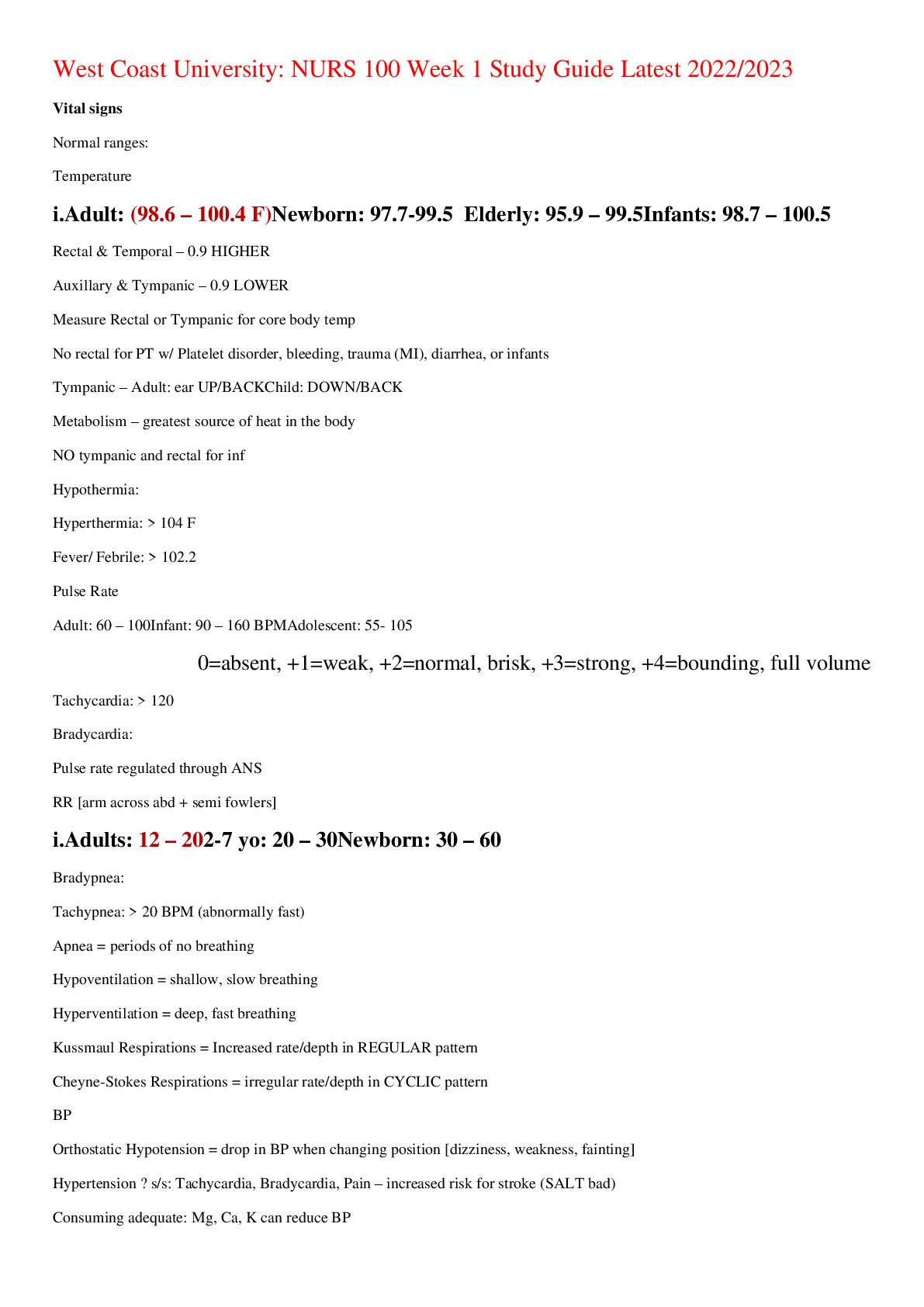
Reviews( 0 )
Recommended For You
Business> EXAM > BIS 221 Introduction To Computer Applications And Systems{BIS 221 Week 1 Study Suide-2018/19 MS Word 2016} {Score-94} (All)
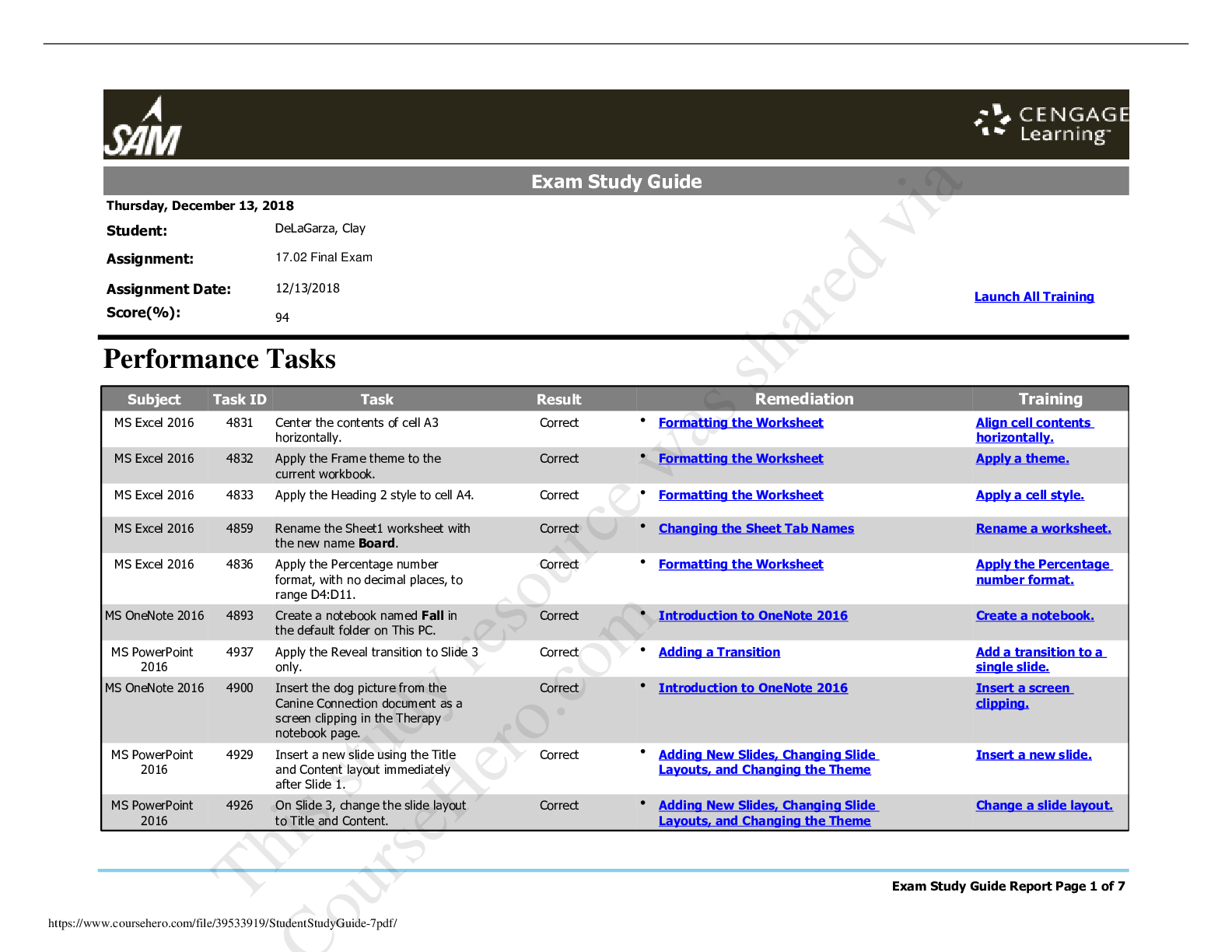
BIS 221 Introduction To Computer Applications And Systems{BIS 221 Week 1 Study Suide-2018/19 MS Word 2016} {Score-94}
BIS 221 Week 1 MS Word 2016 Quiz (20 Task and Answers) Display the Word Count dialog box and include words in text boxes, endnotes, and footnotes in the count. Show the formatting marks in the docum...
By Expert#1 , Uploaded: Sep 09, 2019
$5
Education> EXAM > South University NSG5003 Week 1 Study Guide (Chapter 1 & 2) Latest (63 questions) (All)
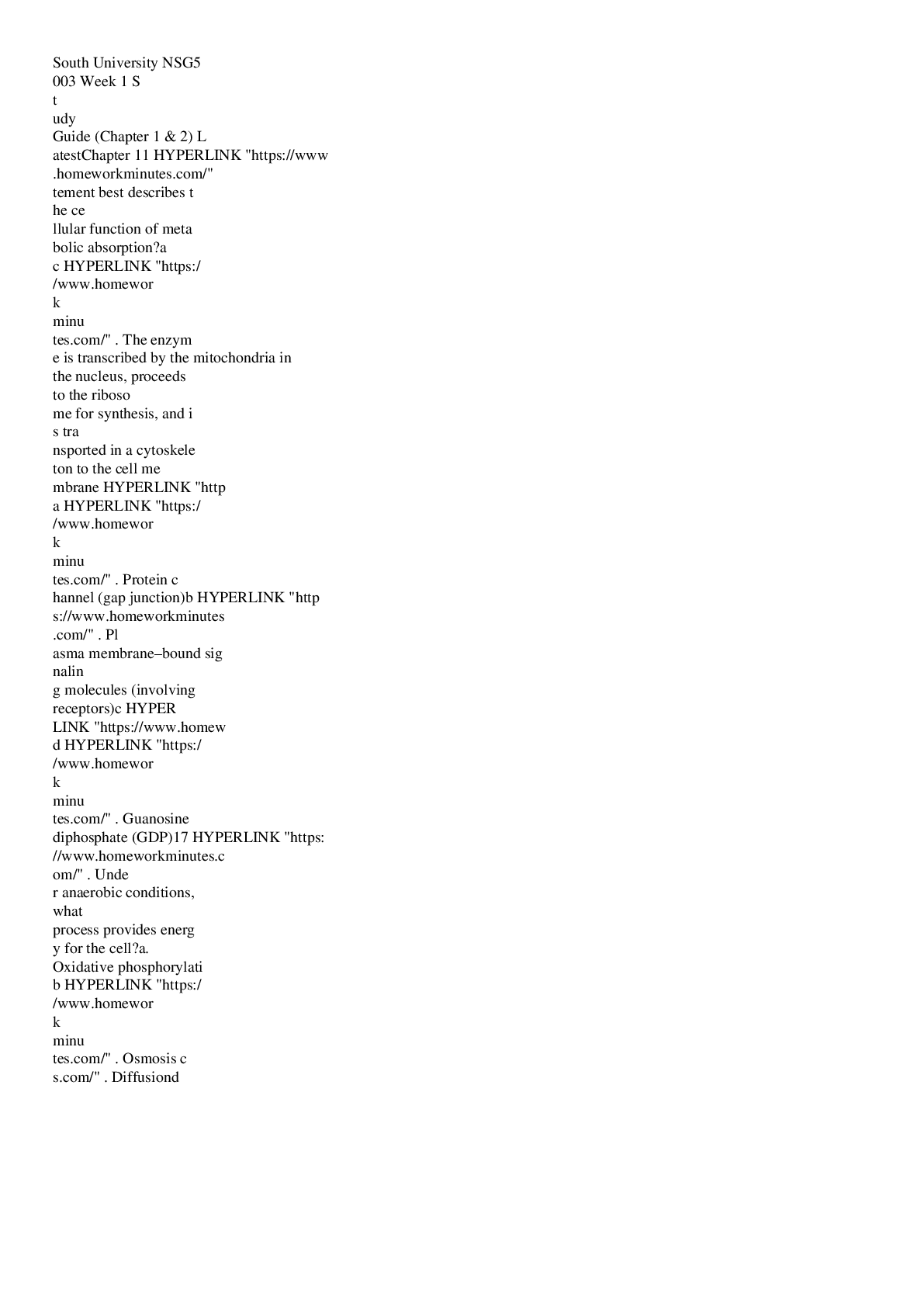
South University NSG5003 Week 1 Study Guide (Chapter 1 & 2) Latest (63 questions)
Chapter 1 1. Which statement best describes the cellular function of metabolic absorption? a. Cells can produce proteins. b. Cells can secrete digestive enzymes. c. Cells can take in and...
By alan2028 , Uploaded: May 03, 2022
$27
Education> EXAM > South University NSG5003 Week 1 Study Guide/South University NSG5003 Week 1 Study Guide (All)

South University NSG5003 Week 1 Study Guide/South University NSG5003 Week 1 Study Guide
Chapter 1: Cellular Biology 1. Which statement best describes the cellular function of metabolic absorption? a. Cells can produce proteins. c. Cells can take in and use nutrients. b....
By alan2028 , Uploaded: Apr 28, 2022
$17
*NURSING> EXAM > NR565 Week 1 Study Outline( Complete Solution Rated A) (All)
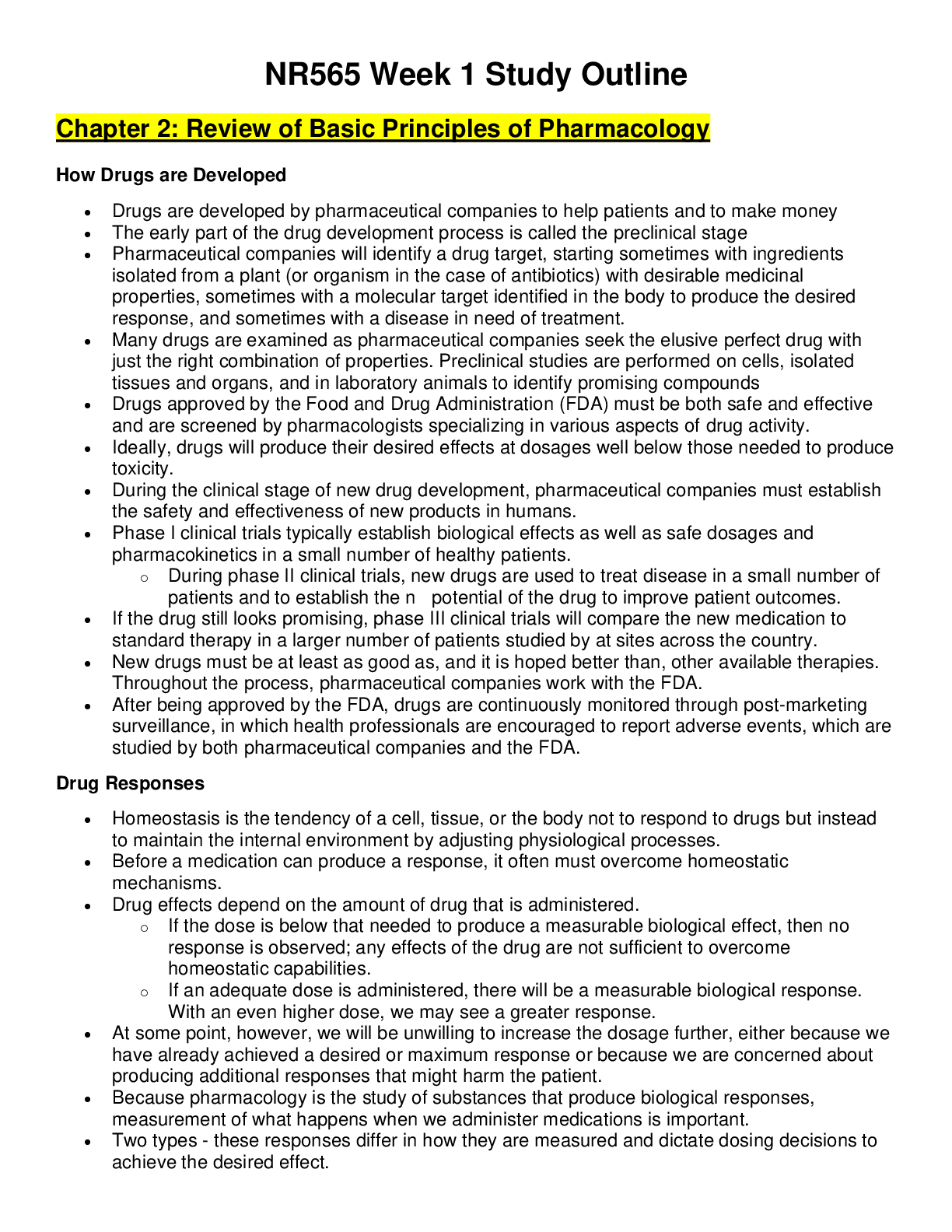
NR565 Week 1 Study Outline( Complete Solution Rated A)
NR565 Week 1 Study Outline Chapter 2: Review of Basic Principles of Pharmacology How Drugs are Developed • Drugs are developed by pharmaceutical companies to help patients and to make money • The...
By Axel , Uploaded: Jul 13, 2021
$18
*NURSING> EXAM > NSG 6020 WEEK 1 HISTORY AND ASSESSMENT STUDY GUIDE / NSG6020 WEEK 1 STUDY GUIDE (LATEST -2021): SOUTH UNIVERSITY (All)

NSG 6020 WEEK 1 HISTORY AND ASSESSMENT STUDY GUIDE / NSG6020 WEEK 1 STUDY GUIDE (LATEST -2021): SOUTH UNIVERSITY
NSG 6020 WEEK 1 HISTORY AND ASSESSMENT STUDY GUIDE / NSG6020 WEEK 1 STUDY GUIDE (LATEST -2021): SOUTH UNIVERSITY
By kofee , Uploaded: Apr 29, 2021
$10
*NURSING> EXAM > NR565 / NR 565 Week 1 Study Questions : Advanced Pharmacology Fundamentals - Chamberlain (All)
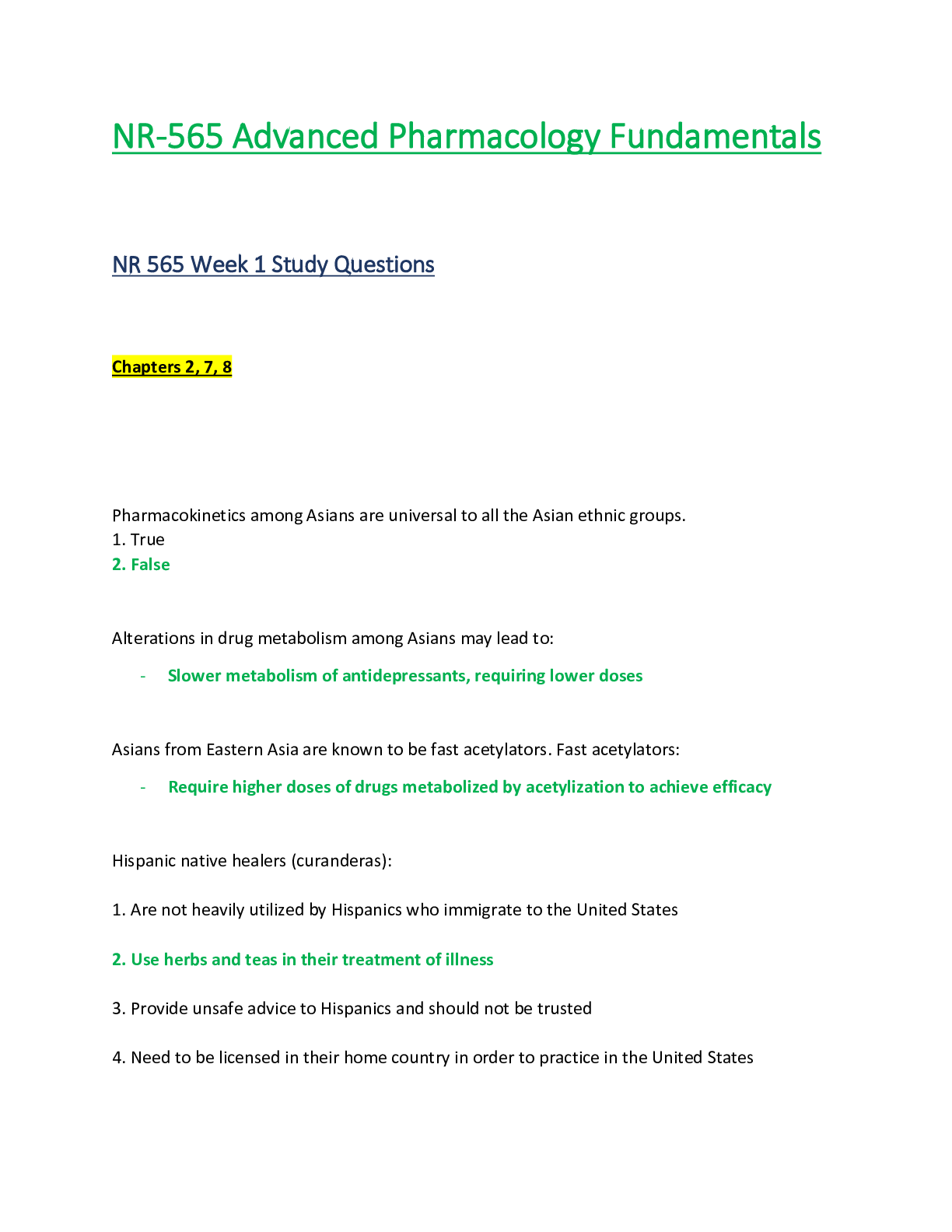
NR565 / NR 565 Week 1 Study Questions : Advanced Pharmacology Fundamentals - Chamberlain
NR 565 Week 1 Study Questions - Chapters 2 & 7 & 8
By quiz_bit , Uploaded: Feb 18, 2021
$6
*NURSING> EXAM > NR 565 / NR565 Advanced Pharmacology Fundamentals Week 1 Study Guide| Chapters 2,7,8 | 2020/2021| Complete Guide |Chamberlain College (All)

NR 565 / NR565 Advanced Pharmacology Fundamentals Week 1 Study Guide| Chapters 2,7,8 | 2020/2021| Complete Guide |Chamberlain College
NR 565 / NR565 Advanced Pharmacology Fundamentals Week 1 Study Guide| Chapters 2,7,8 | 2020/2021| Complete Guide |Chamberlain College Chapter 2: Review of Basic Principles of Pharmacology How Dr...
By nurse_steph , Uploaded: Nov 23, 2020
$11
*NURSING> EXAM > NR 565 / NR565 Advanced Pharmacology Fundamentals Week 1 Study Guide| Chapters 2,7,8 | 2020/2021| Complete Guide |Chamberlain College (All)

NR 565 / NR565 Advanced Pharmacology Fundamentals Week 1 Study Guide| Chapters 2,7,8 | 2020/2021| Complete Guide |Chamberlain College
NR 565 / NR565 Advanced Pharmacology Fundamentals Week 1 Study Guide| Chapters 2,7,8 | 2020/2021| Complete Guide |Chamberlain College Chapter 2: Review of Basic Principles of Pharmacology How Dr...
By nurse_steph , Uploaded: Nov 23, 2020
$11
*NURSING> EXAM > NR 509 week 1 study guide (All)
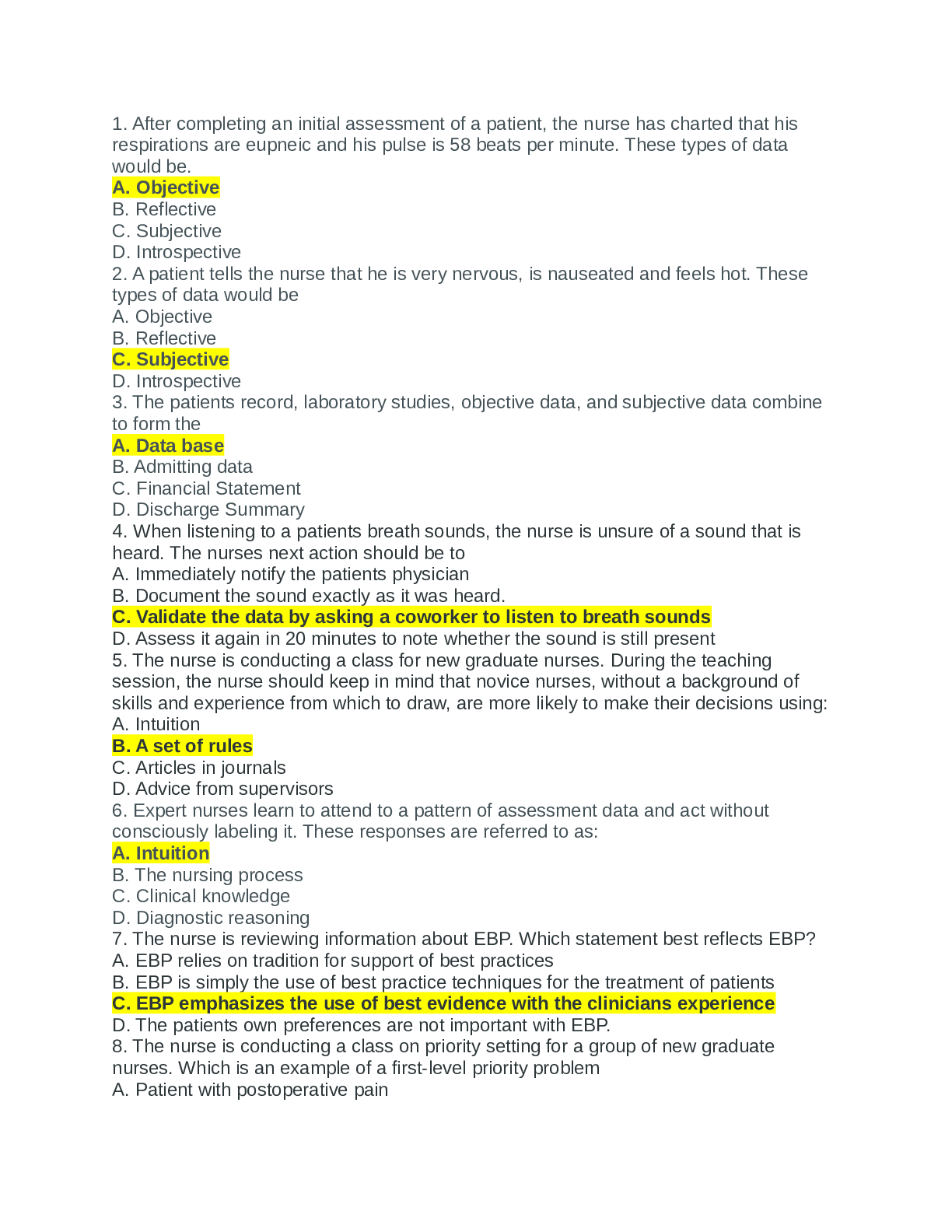
NR 509 week 1 study guide
NR 509 week 1 study guide
By sweetgrades , Uploaded: Nov 17, 2020
$15
*NURSING> EXAM > NR 511 Week 1 Study Guide Question And Answers| Complete Solution A+ Guide (All)
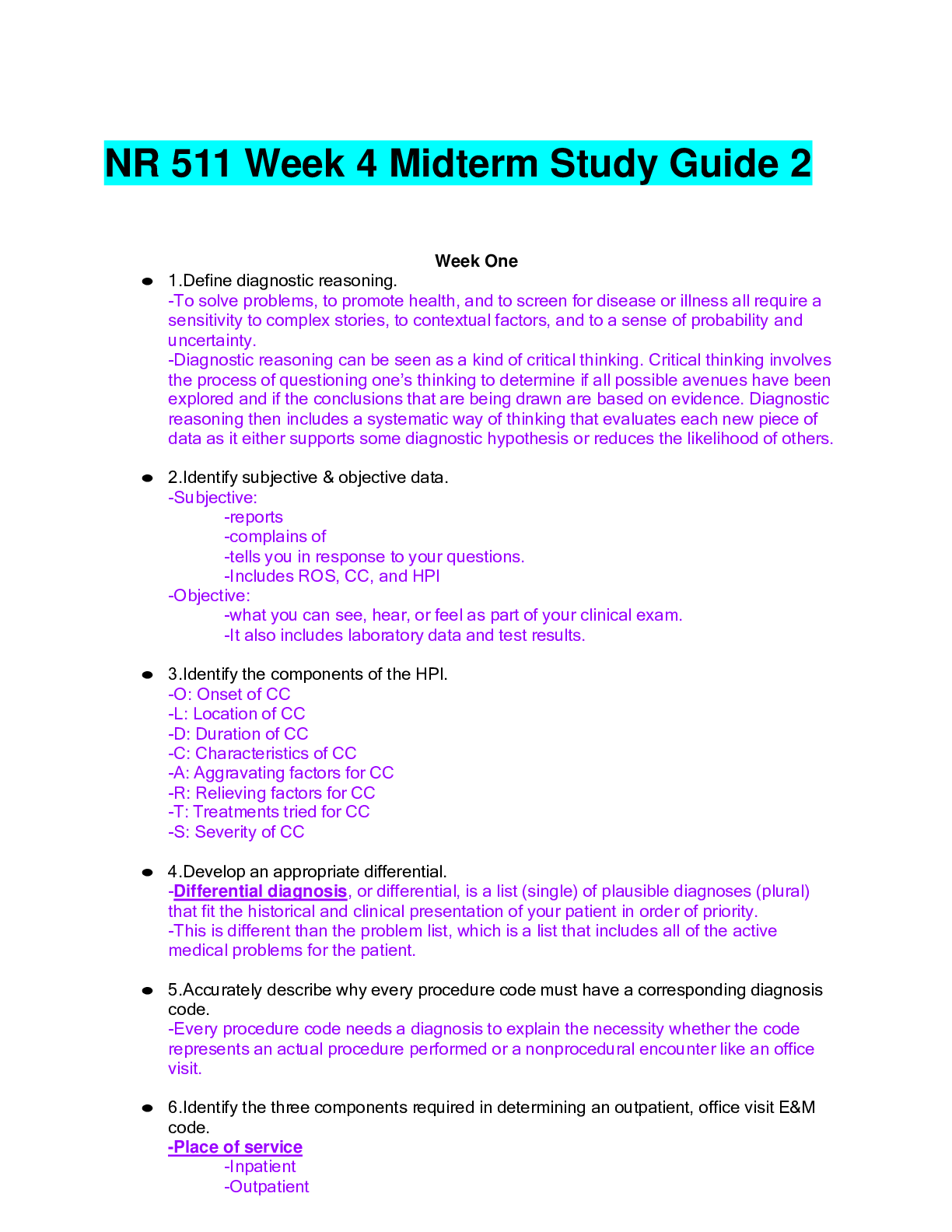
NR 511 Week 1 Study Guide Question And Answers| Complete Solution A+ Guide
NR 511 Week 1 Study Guide Define diagnostic reasoning. Identify subjective & objective data. Identify the components of the HPI. Develop an appropriate differential. Describe the differences betw...
By succeeded , Uploaded: Jan 09, 2021
$18
Document information
Connected school, study & course
About the document
Uploaded On
Mar 24, 2023
Number of pages
6
Written in
Additional information
This document has been written for:
Uploaded
Mar 24, 2023
Downloads
0
Views
41






